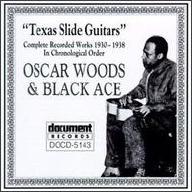Not long after arriving in Shreveport, Woods began a long association with guitarist Ed Schaffer, and together they performed as the Shreveport Home Wreckers, often appearing at The Blue Goose Grocery and Market, a notorious Shreveport establishment said to be an after-hours speakeasy. Woods and Schaffer made their first two recordings as the Shreveport Home Wreckers for Victor in Memphis on May 31, 1930. For someone whose handle was "The Lone Wolf," Woods was extraordinarily lucky in terms of the number of recording dates he was able to secure in connection with other artists. From this first session up until his last, a field recording for the Library of Congress made on October 8, 1940, Woods was involved in the making of no less than 35 sides.
On May 27 and 28, 1931, Ed Schaffer was in Charlotte, NC, recording six sides headed by white country artist (and future Governor of Louisiana) Jimmie Davis along with New Orleans-based jazz guitarist Ed Snoozer Quinn. Nearly a year later in Dallas, TX (on February 8, 1932) Davis made four sides with the Shreveport Home Wreckers as accompanists, and then the Home Wreckers made another pair of sides on their own, issued this time on Victor as by "Eddie and Oscar." These sides are of key sociological importance as they are the first known Southern-made records of country blues made by a "mixed race" group. Needless to say, Victor did not go out of their way to publicize this aspect upon the initial release of these sides, which occurred during the worst year in the history of the record market. However, some old timers recalled that the association between Jimmie Davis and the Shreveport Home Wreckers didn't just end at the recording studio door -- amazingly, they also toured together.
Oscar Buddy Woods did not record again until made a trip to New Orleans to make some solo records for Decca on March 21, 1936. One of these recordings was of Woods' signature tune, Lone Wolf Blues, and another his first recording of Don't Sell It, Don't Give It Away. These did so well in the race record market that Jimmie Davis took a renewed interest in the Shreveport Home Wreckers. By the time Woods returned to record making in a session set up by Davis in San Antonio on October 30-31, 1937, the lowly two-man Home Wreckers had expanded into a six- or seven-piece string band called the Wampus Cats. The Wampus Cats also included a female vocalist by the name of Kitty Gray, guitarist Joe Harris, and mandolinist Kid West. The Wampus Cats made an additional session in Dallas on December 4, 1938, on which Kitty Gray does not appear, but unknown trumpet and saxophone players are therein added to the mix.
After Oscar Buddy Woods cut his last five selections for the Library of Congress in 1940, he disappeared from public notice until his death in 1956. On the same date as Woods, Wampus Cats alumni Joe Harris and Kid West also recorded 11 pieces for the Library of Congress as a duo. As in the case of Woods, they were never heard from again. Ed Schaffer is even more obscure than his compatriots, and may have died even before the San Antonio sessions with the Wampus Cats, as he is not known to have been present on that occasion. According to entries in Shreveport city directories, Woods stayed in the Shreveport area in his final years, playing dances and working as a street musician.
The impact of Oscar Buddy Woods on the development of bottleneck slide playing was crucial; one musician he took under his wing around 1930 was Texas native Babe Kyro Lemon Turner, who later assumed the name Black Ace. During his lifetime, Woods was best-known for Lone Wolf Blues, but today the most often anthologized cut in which he was involved is the Wampus Cats' version of Don't Sell It,-Don't Give It Away. Also, bluesman Robert Johnson paid the Shreveport Home Wreckers an offhand tribute by lifting one verse practically verbatim out of their 1932 Flying Crow Blues and using it as the concluding verse in his own Love in Vain. ~ Uncle Dave Lewis, Rovi












